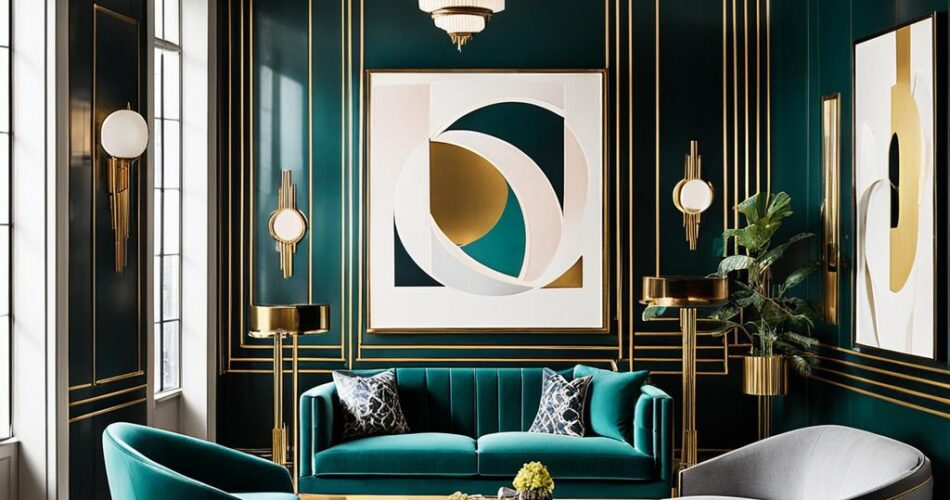The art deco design style soared in the 1920s and 1930s. It exuded timeless elegance and sophistication. This movement featured geometric shapes, rich colors, sleek patterns, and luxurious materials.
Art deco decor embraced streamlined aesthetics while appreciating craftsmanship and luxury. It showcased streamlined silhouettes and lavish materials. Statement lighting fixtures elevated living spaces with intricate geometric patterns.
Ornate mirrors and reflective surfaces added depth and drama. The style drew exotic influences, resulting in geometric precision fused with worldly inspirations.
Key Takeaways
- Art deco interior design flourished in the 1920s and 1930s as a reaction to Art Nouveau’s ornate aesthetic.
- Geometric shapes, bold colors, intricate patterns, and luxurious materials define the art deco style.
- Art deco embraced streamlined forms while celebrating exquisite craftsmanship and exotic influences.
- Iconic elements include statement lighting, mirrored surfaces, and furniture with sleek silhouettes.
- This timeless style infuses interiors with elegance, glamour, and a sense of historical sophistication.
The Birth of Art Deco: A Glimpse into History
The Art Deco movement emerged between 1920-1930. It captured modernization and cultural evolution’s spirit. Its origins traced back to pre-World War I France.
However, it gained global prominence at the 1925 Paris Exposition. There, its vibrant style showcased to an international audience.
Origins of Art Deco
Art Deco drew inspiration from Art Nouveau’s flowing lines and natural motifs. Yet, it represented a shift towards streamlined, geometric aesthetics.
It embraced abstract Cubist forms, Bauhaus machine-like shapes. It included influences from ancient Egyptian, African, and Aztec art.
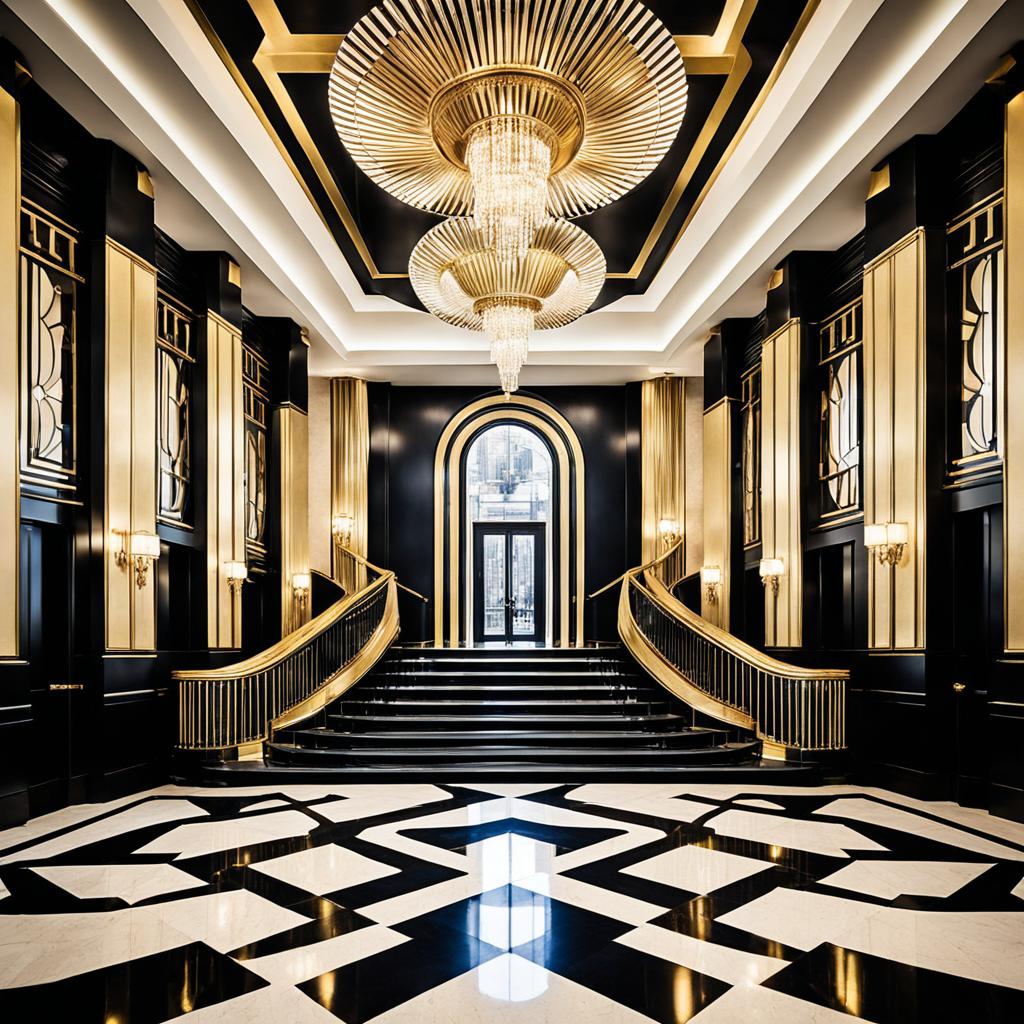
Influences on Art Deco
The Art Deco style drew from diverse artistic movements like Fauvism and Orphism. It also took cues from avant-garde Ballets Russes productions.
These influences contributed to Art Deco’s bold shapes, metallics, and retro decor elements.
Technological Innovations
Technological advancements like skyscrapers, stainless steel, aluminum, and lacquers impacted Art Deco. They inspired its sleek symmetry and geometric motifs.
These reflected the industrial and modernist sensibilities of that era.
Art Deco left an indelible mark across artistic disciplines, from European graphic design to US architecture.
Its reach extended beyond the Western world, influencing regions like South America, Asia, and Africa.
The style permeated media like film, fashion, and interior design, shaping set designs, costumes, and home decor.
| Year | Event | Significance |
|---|---|---|
| 1925 | Exposition Internationale des Arts Décoratifs et Industriels Modernes | Showcased Art Deco style to a global audience |
| 1930 | Completion of the Chrysler Building | Iconic Art Deco architecture in New York City |
| 1932 | Opening of Radio City Music Hall | Art Deco interior design and lavish decor |
Today, Art Deco buildings represent historical and cultural significance. They are preserved as heritage sites for future generations.
People appreciate the symmetrical shapes and lavish decor defining this remarkable architectural and design movement.
The Hallmarks of Art Deco Interior Design
The Art Deco interior style embodied glamour and luxury. Its bold geometric shapes, rich materials, and intricate patterns fused art and modernity.
It expressed 20th-century sleek, opulent design.
Geometric Shapes
Angular forms and zigzag patterns dominated Art Deco interiors. These created a dynamic, symmetrical sense of movement.
From chevron motifs to stepped archways, geometric shapes lent a modern flair. They embraced the machine-age inspirations.
Luxurious Materials
Indulgent materials elevated Art Deco spaces into refined luxury realms. Rare woods like ebony and zebrawood adorned furniture and paneling.
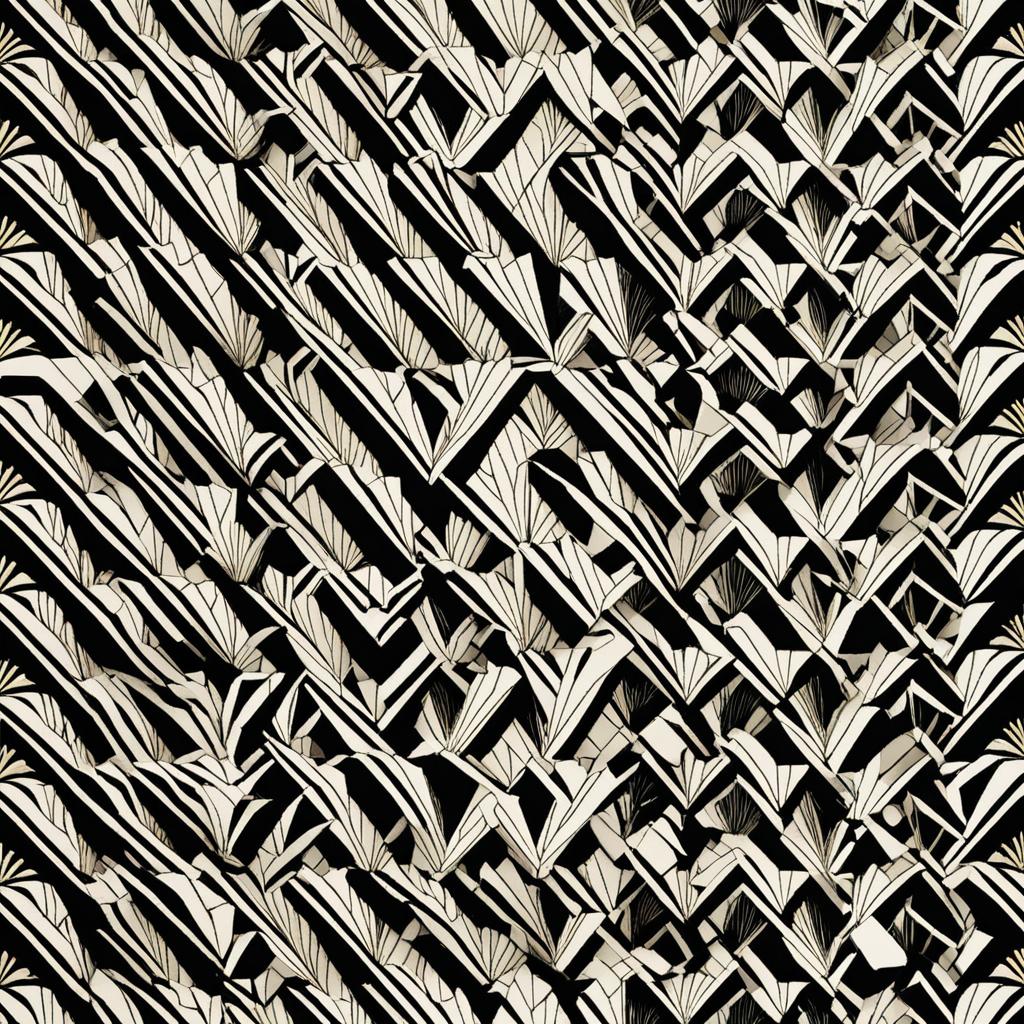
Bold Color Schemes
Vibrant jewel tones and high-contrast palettes typified Art Deco interiors. Deep blues, emerald greens, and burgundies commanded attention.
They often paired with luxurious gold, silver, or black accents. This created a vintage yet daring look.
Intricate Patterns
Art Deco embraced ornate, glamorous, and sophisticated patterns. These ranged from stylized florals to sunburst motifs.
These intricate details adorned walls, floors, textiles, and accessories. They exuded a sense of opulent artistry throughout.
Mirrors and Reflective Surfaces
Decorative geometric or sunburst-designed mirrors reflected the era’s love for shine. Glossy polished wood and lacquered finishes enhanced luxury.
Streamlined Furniture
While ornamental in detail, Art Deco furniture had modern silhouettes. Curved forms and sleek lines defined seating, cabinetry, and tables.
These were often exotic wood or gleaming metal inlay accented.
Statement Lighting
Opulent light fixtures cast a warm, glamorous glow. Angular chandeliers, sconces, and lamps featured geometric motifs and metallic finishes.
They served as sculptural focal points illuminating lavish details.
Exotic Influences
Art Deco interiors incorporated ancient cultural elements like Egyptian lotus patterns. Aztec animal motifs and Asian lacquerwork added worldly sophistication.
Art Deco Interior Design: Masterful Fusion of Art and Industry
Art Deco emerged in the 1920s, reacting against the naturalistic art nouveau style. It fused artistic principles with industrial design. Drawing from art nouveau’s curved lines, it shifted towards modernity with geometric forms, symmetrical designs, and new materials and construction techniques.
Art Deco interior design expertly combined intricate details and craftsmanship with industrial aesthetics. It created a timeless elegance, drawing inspiration from vintage decor and ultra-modern elements.
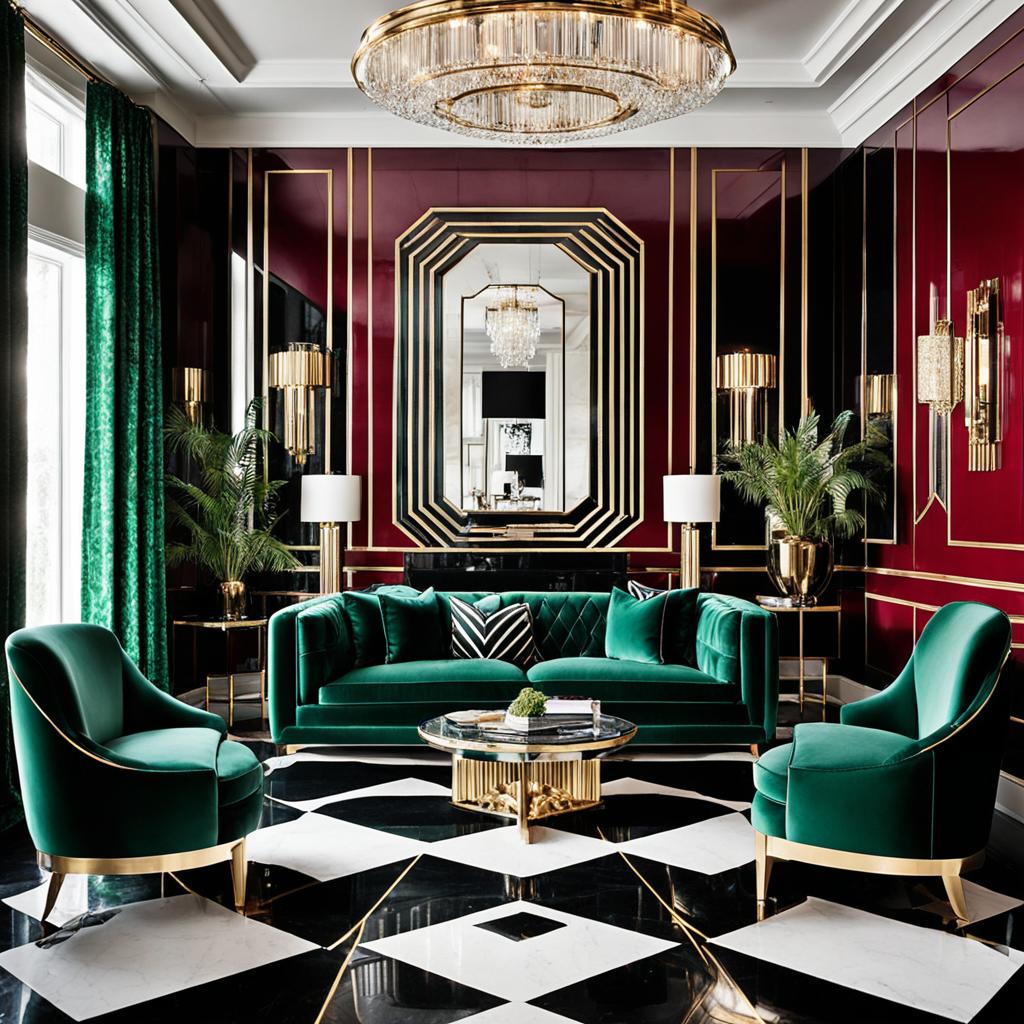
Opulent decor marked Art Deco interiors, featuring luxurious materials like exotic woods, chrome, glass, and lacquered finishes. Bold color palettes with deep jewel tones were prevalent, often complemented by intricate patterns and strategically placed mirrors to enhance space.
Furniture embodied streamlined, angular shapes, while lighting fixtures showcased geometric motifs, reflecting the era’s celebration of industrial design. Art Deco interiors also incorporated art nouveau influences and exotic inspirations from Africa, Asia, and the Middle East, creating a harmonious blend.
| Art Deco Elements | Description |
|---|---|
| Geometric Shapes | Sharp angles, chevrons, stepped forms |
| Luxurious Materials | Polished rare woods, glass, chrome, lacquered finishes |
| Bold Color Schemes | Deep jewel tones like emerald, sapphire, ruby |
| Intricate Patterns | Sunbursts, zigzags, stylized florals |
| Reflective Surfaces | Large ornate mirrors, glossy tiles |
| Furniture | Sleek, angular yet curved silhouettes |
| Lighting | Statement chandeliers and sconces with geometric motifs |
| Exotic Influences | Wood inlays, accessories from non-Western cultures |
The Art Deco movement seamlessly integrated art and industry, blending intricate craftsmanship with streamlined aesthetics. This fusion resulted in opulent decor celebrating vintage inspirations and cutting-edge design principles, leaving an indelible mark.
Bringing Art Deco into Your Home
The Art Deco movement brought lavish decorations and glamorous ambiance. To capture this iconic style, select a bold color palette. Deep jewel-like hues like sapphire blues, emerald greens, or metallics work well.
Embrace Geometric Patterns
Art Deco design embraces ornamental motifs and geometric patterns. Incorporate these through wallpapers, curtains, or rugs featuring chevrons, zigzags, or sunburst designs.
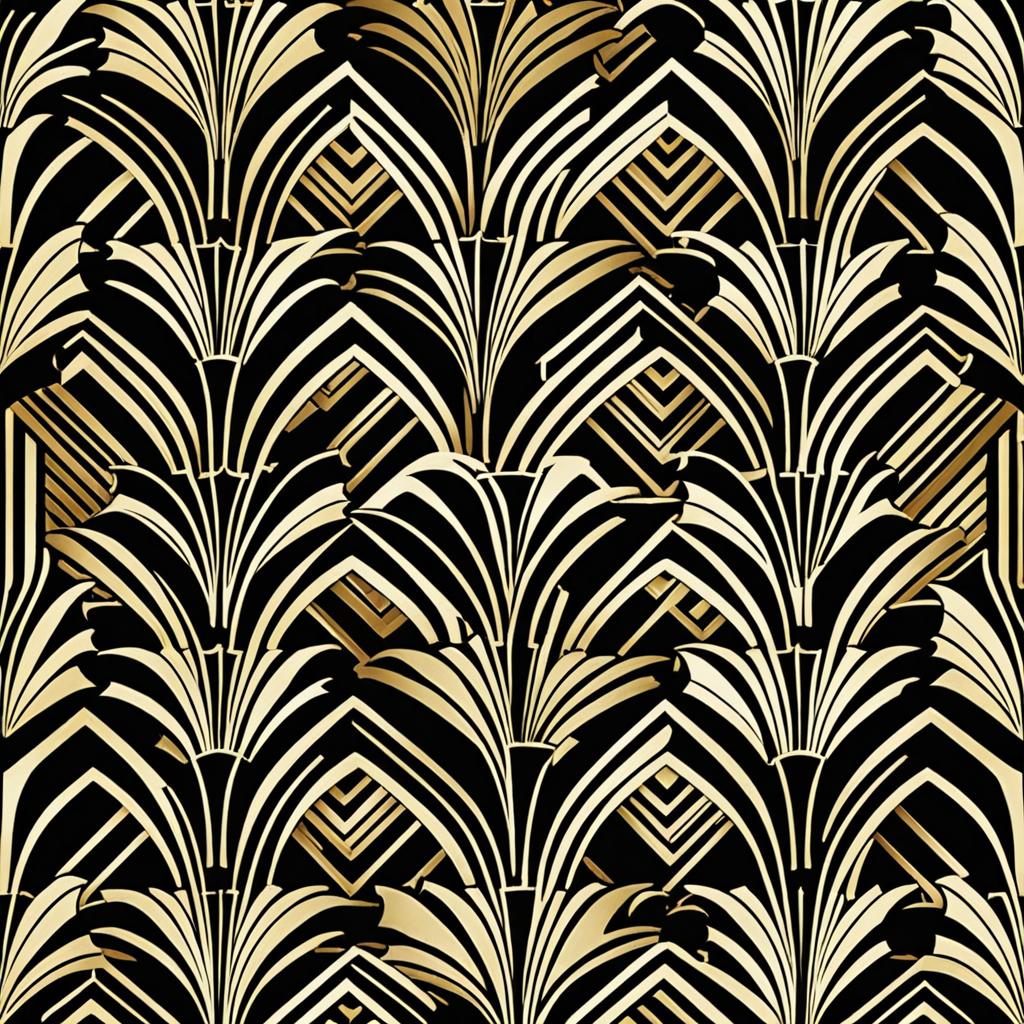
Invest in Statement Furniture
Art Deco interiors need luxurious furnishings for sophistication. Invest in sleek, curved pieces crafted from exotic woods or lacquered finishes. These streamlined silhouettes elevate the space.
Lighting that Shines
Enhance rooms with eye-catching chandeliers or wall sconces. Feature geometric patterns and metallic accents. These statement pieces cast an inviting glow while embodying opulence.
Mirrors Galore
Large, ornate mirrors are quintessential Art Deco elements. They create luxury and space while reflecting vibrant colors and bold motifs.
Art and Accessories
Accessorize with decorative sculptures, vases, or fans exhibiting art deco textiles and vintage aesthetics. These add depth and character while paying homage.
Balance is Key
While Art Deco celebrates opulent textiles and motifs, leave some spaces uncluttered. This creates harmony, allowing appreciation of individual design elements.
Flooring Choices
Complete your sanctuary with floors complementing the aesthetic. Glossy geometric tiles or warm wood provide perfect foundations.
Strategically placed area rugs add depth and texture.
| Material | Color | Pattern | Texture |
|---|---|---|---|
| Exotic Woods | Deep Jewel Tones | Chevrons | Polished Lacquer |
| Stainless Steel | Metallics | Zigzags | Etched Glass |
| Velvet | Rich Burgundy | Sunbursts | Sumptuous Upholstery |
Art Deco Architecture: A Lasting Legacy
The Art Deco movement left an unforgettable mark on architecture. Iconic structures like the Chrysler Building and Empire State Building epitomized the style’s retro aesthetics. These skyscrapers embodied 1920s interior style with sleek vertical lines and lavish decorative elements.
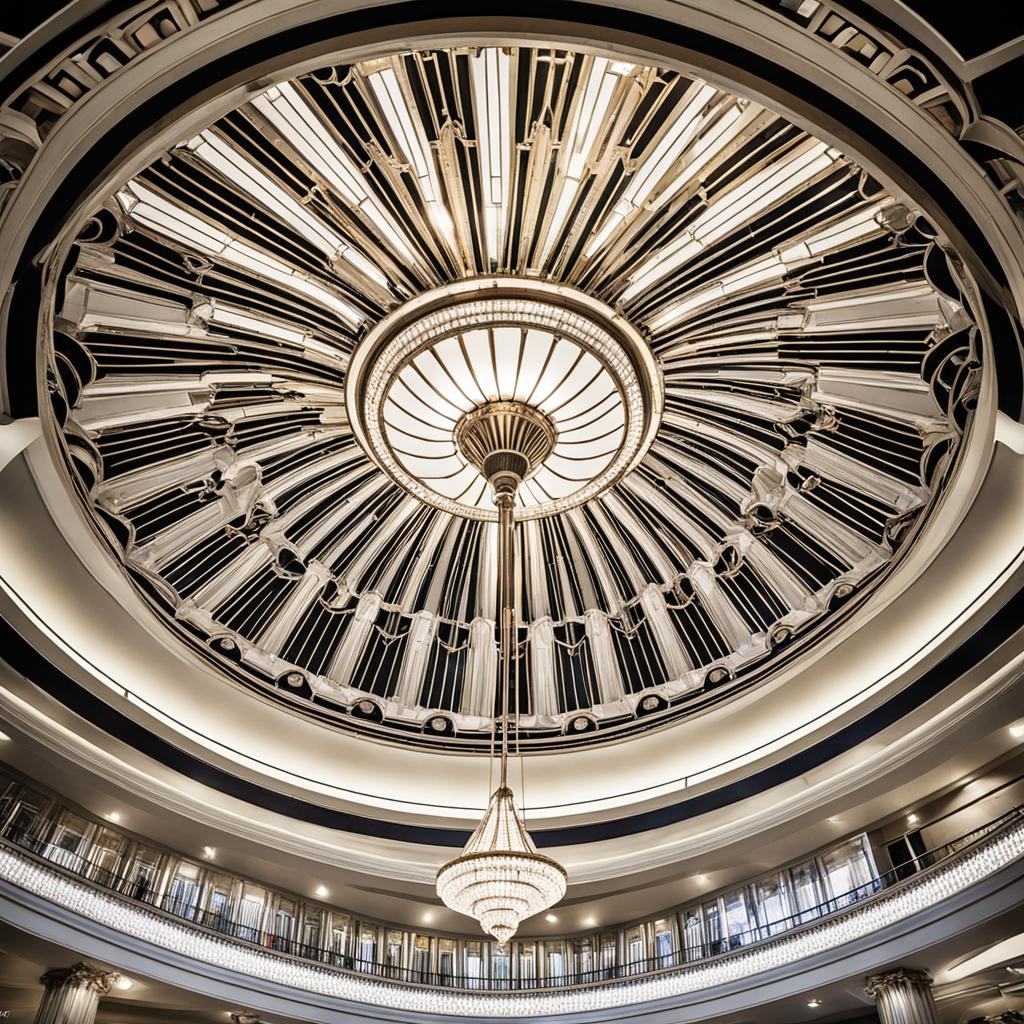
While contemporary trends eventually surpassed Art Deco, its interior design influence remains significant. The style’s sophisticated blend of symmetry, luxury, and retro flair ensures its enduring appeal. This manifests in art deco renovations of historic sites and new art deco style homes.
The Chrysler Building, completed in 1930, stands as a pinnacle of Art Deco style, featuring long lines, smooth curves, and unusual streamlined gargoyles mimicking car hood ornaments.
Beyond iconic skyscrapers, Art Deco architecture has left an indelible American landscape mark. Numerous original structures still exist as registered historical landmarks.
These buildings exemplify Art Deco opulence and glamour through extensive surface ornamentation. From courthouses and schools to theaters and luxury homes.
While lavish ornamentation was more prominent in interiors, architects and Hollywood set designers collaborated during Art Deco’s heyday. This helped elevate the style’s popularity.
Consequently, many private homes featured traditional exteriors but incorporated art deco interior influences. Furniture, art, and household items reflected the cultural fascination with ancient civilizations and exotic influences.
Art Deco: A Celebration of Luxury and Modernity
At its core, Art Deco blended luxury with modernity. Lavish furnishings like exotic woods, polished metals, and rich upholsteries adorned streamlined, angular forms. Decorative motifs honored vintage inspirations while embracing sleek machine age aesthetics.
This synergy resulted in opulent yet modern living spaces exuding elegance and glamour. From entryways to living rooms, Art Deco blended Art Nouveau influences with sleek, 20th-century design.
The luxurious decor celebrated finest materials like rare woods, metals, and sumptuous textiles. These were crafted into glamorous furniture with streamlined shapes defying ornate excess while exuding sophistication.
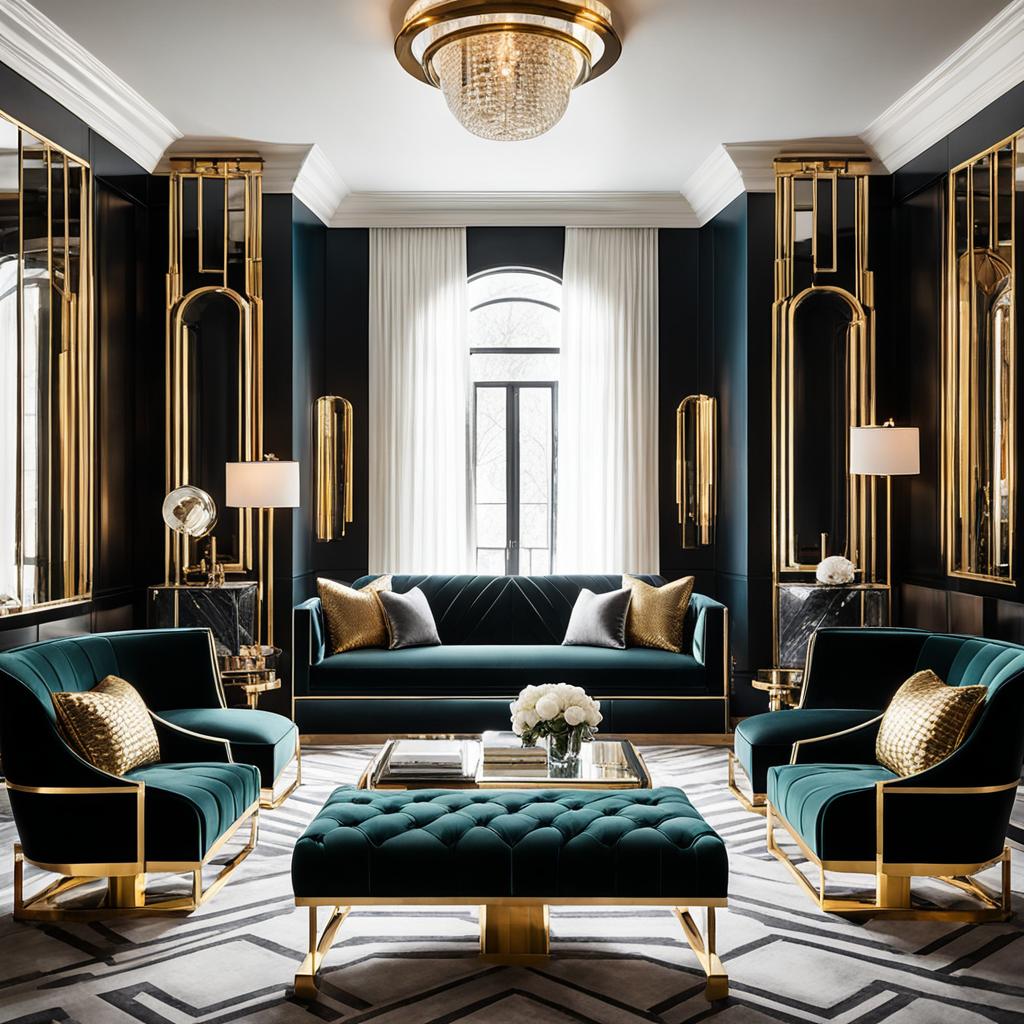
Opulent furniture like intricately carved armchairs, lacquered cabinets, and bold geometric sofas transformed spaces. These glamorous living spaces epitomized the Art Deco aesthetic. Whether wood inlays or metallic accents, these pieces blended artistry with industrial design.
| Art Deco Hallmarks | Description |
|---|---|
| Geometric Shapes | Sharp angles, chevrons, and stepped forms |
| Luxurious Materials | Exotic woods, glass, chrome, lacquered finishes |
| Bold Color Palettes | Deep jewel tones, black, gold, and silver |
| Intricate Patterns | Sunbursts, zigzags, stylized florals |
From entryways to living rooms, Art Deco seamlessly blended Art Nouveau style influences with sleek, 20th-century design sensibilities.
Incorporating Art Deco Elements in Modern Interiors
Blending opulent Art Deco accents creates timeless sophistication in contemporary interiors. Strategic space planning balances ornate Deco pieces against functional, uncluttered layouts.
Thoughtful planning prevents lavish materials from overwhelming the space. Clean lines highlight statement Art Deco elements as focal points.
Color Schemes
Use rich jewel tones judiciously to highlight luxury. Pair bold sapphire, emerald, or ruby with black and metallics.
Textures and Finishes
Polished veneers, lacquered finishes, and satin metallics reinforce Art Deco sleekness. Incorporate these through statement lighting, sculpted furniture with stylized motifs.
Mix eclectic 1920s-inspired elements with ornate Deco pieces, rich palettes, and lavish materials. Infuse contemporary interiors with elegant Art Deco flair.
Case Studies: Iconic Art Deco Interiors
The Art Deco style left a lasting impact on architecture. Its influence extended to interior design, blending luxurious materials, symmetrical compositions, and ornate details.
These spaces exuded opulent glamour and retro sophistication.
The Chrysler Building, New York City
The Chrysler Building’s lobby showcases Art Deco design excellence. Mahogany paneling adorns the walls, while marble floors set the scene.
Edward Trumbull’s ceiling mural epitomizes Art Deco’s integration of lavish materials and ornate art.
Palais de Chaillot, Paris
Paris’s Palais de Chaillot stands as a monument to French luxury and symmetry. Its marble-inlaid halls feature stylized decorative panels.
The palace’s spaces exude understated glamour, harmonizing Art Deco’s symmetrical compositions and metal accents.
Eltham Palace, London
Eltham Palace in London seamlessly fuses medieval architecture with lavish Art Deco interiors. Visitors are transported to an era where retro style and modernity coexisted.
Exotic burl wood rooms and a circular glass-domed entrance hallway epitomize Art Deco’s glamorous aesthetics.
These spaces blend opulent ornamentation with sleek lines, creating an unforgettable ambiance.
| Site | Location | Notable Features |
|---|---|---|
| The Chrysler Building | New York City, USA | Exotic mahogany paneling, marble floors, ornate ceiling mural |
| Palais de Chaillot | Paris, France | Marble-inlaid halls, stylized decorative panels, symmetrical compositions |
| Eltham Palace | London, UK | Exotic burl wood rooms, circular glass-domed entrance, retro-modern fusion |
These iconic sites showcase Art Deco’s mastery of material richness, symmetrical ornamental compositions, and the fusion of sleek and glamorous elements.
They are enduring reminders of an era celebrating luxury, modernity, and crafting captivating, imaginative spaces.
Tips for Aspiring Art Deco Interior Designers
To excel in Art Deco interior decorating, immerse yourself in symmetrical forms, rich material palettes like exotic woods and metals, and vibrant color schemes. Understand the roots and contexts of these luxurious vintage elements.
Hands-on coursework and workshops provide guided practice. Blend symmetrical forms, stylized floral motifs or geometric motifs, lavish ornaments, and architectural styles into functional yet glamorous spaces. Channel the decadent 1920s Art Deco spirit.
The Art Deco movement originated at the 1925 International Exhibition of Modern Decorative and Industrial Arts in Paris.
This influential event showcased luxurious furniture pieces that combined materials like wood, leather, and metal. It reflected the era’s artistry and industrial innovation embrace.
The Art Deco palette includes bold, vibrant colors like deep yellows, reds, greens, blues, and pinks. It lends drama and luxurious aesthetics to interior spaces.
Iconic sites like Eltham Palace in London exemplify Art Deco design’s seamless integration within an existing medieval structure. The Palais de Chaillot in Paris showcases symmetrical designs with detailed marble inlays and decorative panels.
To pursue an interior decorating career focusing on Art Deco or other styles, consider this educational path:
| Degree Level | Description |
|---|---|
| Associate’s | At least an associate’s degree is required to become a licensed interior designer. |
| Bachelor’s | A bachelor’s degree is more probable for licensure. |
| Master’s | A master’s degree provides a competitive advantage. |
Interior design programs cover core subjects like interior design, drawing, and computer-aided design (CAD). Beneficial electives include graphic design, color theory, lighting, materials, building codes and standards, and vintage inspiration through art history courses.
Embrace the Art Deco Interior Design Trend
The Art Deco trend continues influencing interior designers. They aim to infuse projects with sophistication and historical richness. Its emphasis merges luxury with modernity through bold lines, opulent ornaments. It integrates vintage interior styles and contemporary elements like antiqued mirrors or metallic finishes.
Art Deco is a versatile style for creating unique yet timeless spaces. Whether undertaking a full Art Deco renovation or introducing era-inspired design accents, thoughtful applications can elevate any interior design. Designers embrace symmetrical aesthetics by incorporating sleek geometrics, rich materials, and vintage-modern fusion.
Homeowners and designers alike appreciate Art Deco’s glamour and indulgence. From bold architectural lines to opulent ornaments adorning furniture and lighting, the style exudes timeless sophistication. It complements both traditional and contemporary settings.
Design experts suggest a muted, retro approach to Art Deco colors. Rich burgundies, sage greens, light blues, and buttery yellows offer a contemporary twist.
Design experts recommend taking a more muted and retro approach to the Art Deco color palette for updated deco interiors. Suggested colors include rich burgundies, sage greens, light blues, and buttery yellows for a contemporary twist on the classic Art Deco style.
By blending vintage styles with modern sensibilities, designers create inviting, awe-inspiring spaces. Antiqued mirrors and metallic finishes add depth and dimension. The style embraces luxurious materials and intricate craftsmanship.
- Embracing fluid, sweeping curves, circular shapes, archways, and rounded corners is recommended to soften the hard lines of modern minimalism in Art Deco interiors.
- Pill-shaped furniture and decor are iconic of the updated deco aesthetic, bringing a sense of nostalgia while maintaining a contemporary sensibility.
- Small details play a significant role in Art Deco design, with upgraded hardware, gilded trimmings, and ornate accents enhancing modern interiors.
The Art Deco interior design trend offers endless possibilities. Through statement chandeliers, intricately carved art nouveau furniture pieces, or bold geometric wallpaper, spaces become visually striking yet deeply rooted in design history.
Conclusion
Art Deco interior design blends luxury and elegance beautifully. This iconic style mixes lavish materials, precise geometry, and exotic inspirations. The result? Remarkably glamorous yet functional living spaces. Art Deco goes beyond fleeting trends, offering limitless custom glamour.
Embrace Art Deco’s bold colors, sleek lines, and ornate details. Designers craft refined interiors celebrating an iconic era’s craftsmanship. Indulge in the magic of Art Deco to elevate surroundings.
Incorporate glamorous wallpapers, sculpted motif furniture, and statement lighting. These accents infuse spaces with the 1920s-30s’ opulent spirit. Carefully curated Art Deco transforms ordinary rooms into sophisticated havens.
Desire a full retro renovation or subtle touches? Art Deco offers timeless refined living. Sumptuous materials, symmetrical forms, and decadent details radiate unparalleled elegance.
